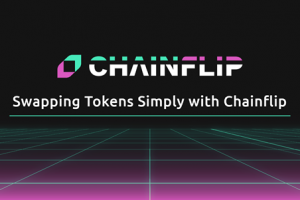How Chainflip Solves Frictionless Cross Chain Swapping

Chainflip is a decentralized protocol under development that supports the native cross-chain exchange of cryptocurrencies without a trusted intermediary. Through Chainflip, users get the same permissionless experience as Uniswap, but without the limitation of being stuck on the Ethereum blockchain or limited to ERC20 tokens. Users can swap their tokens directly without putting their trust in wrapped tokens or suffering from the myriad of user experience issues and tradeoffs that current offerings propose.
Chainflip has its own Substrate-based Proof of State blockchain known as State Chain. All balances, swaps and events are tracked on this blockchain, meaning that users only incur simple transaction costs for the blockchains they interact with. Chainflip can support any generic decentralized transaction network as long as it meets the minimum security guarantees.
The challenges in Cross Chain DEXs
The market lacks a product that facilitates low-friction cross-chain swaps as a fully decentralized protocol without imposing usability tradeoffs that prevent mainstream adoption. The solution should allow users to choose the assets to be swapped, provide the destination address for the receiving chain and have a deposit address generated. This address allows users to swap funds from one chain to another regardless of the wallet they are using. The cross-chain protocols in the market and also those that have been proposed in the recent past do not provide this optimal user experience.
Although there have been projects trying to overcome some of these challenges, most of them have designed solutions that introduce user experience tradeoffs that prevent non-native crypto users from actually using these protocols. l
Other projects have been able to deliver on the user experience side with intuitive cross-chain swaps but have been unable to deliver on the decentralization aspect.
For instance, Shapeshift was fast, intuitive and provided optimal cross-chain experience. However, despite attracting huge volumes, it was essentially a centralized brokerage service that later on was forced by regulators to follow KYC/AML guidelines, leading to a complete loss of traction for the product. Shapeshift could no longer be natively integrated into wallets and other services that made it simple to swap crypto. Therefore, there was no longer any advantage of using the platform.
The right solution should make swapping tokens as simple as Shapeshift back in the days but without centralization. That is why Chainflip is developing a generic cross solution that will pave the way for mainstream adoption.
Chainflip value proposition
Infrastructure
Chainflip has built its own blockchain known as the State Chain which acts as the platform’s bookkeeping, consensus and coordination mechanism. This blockchain contains all the data regarding vaults, the rules set for dealing with transactions, how to manage liquidity and swaps, and how validators will come to a consensus. This means that the rules of the AMM are written into the very fabric of the blockchain. It’s a brilliant use case for an application-specific blockchain, but the FLIP token itself is still an ERC20 token. Pretty amazing stuff!
Security and decentralization
Chainflip works through a decentralized network of 150 nodes to connect chains and uses different types of threshold signature schemes to allow validators to create a single joint wallet for each supported chain. The state chain ensures the protocol is secure allowing assets to be moved around.
Advanced multi-party computation
Chainflip will have a unique and quite advanced multi-party computation mechanism that allows the platform to support various blockchains. It will have a system of validators, which also generate and operate large multi-signature vaults. To create the vaults, validators participate in a setup process where new nodes are deterministically chosen to serve in the next active vault. The vaults use different types of threshold encryption depending on the type of blockchain. These factors ensure that the blockchain is functional at all times, and that users do not experience any downtime.
Composability and integration
Chainflip design will allow users to use the platform as a cross-chain DEX but also as a liquidity aggregator. Integrations with other ERC-20 DEXs like Uniswap or Sushiswap will allow users to access any ERC-20 token listed on those platforms. Chainflip will simply route the payment through one of these platforms without the need for the user to know/do anything. Composability will allow Chainflip to tap into the liquidity of many ecosystems enabling users to have access to a wider range of tokens.
FLIP mechanism and scarcity
Every swap that will be conducted on the Chainflip platform will result in the direct buying and burning of a small amount of FLIP tokens through the system’s liquidity pool. The automatic buy and burn mechanism will create a continuous buying pressure for FLIP and provide a possible deflationary model. This buy and burn mechanism a la EIP 1559 will give upside exposure to any user holding the token no matter what quantity they are holding.
Conclusion
Chainflip is set to be the ultimate solution for true cross-chain, native and permissionless swaps. The platform allows users to swap between major blockchains without any specific wallets, specialized software or wrapped/synthetics counterparty tokens. It is set to solve many challenges currently found in existing cross-chain platforms, by providing an intuitive, seamless interface to connecting assets from different blockchains.
Source: Read Full Article
